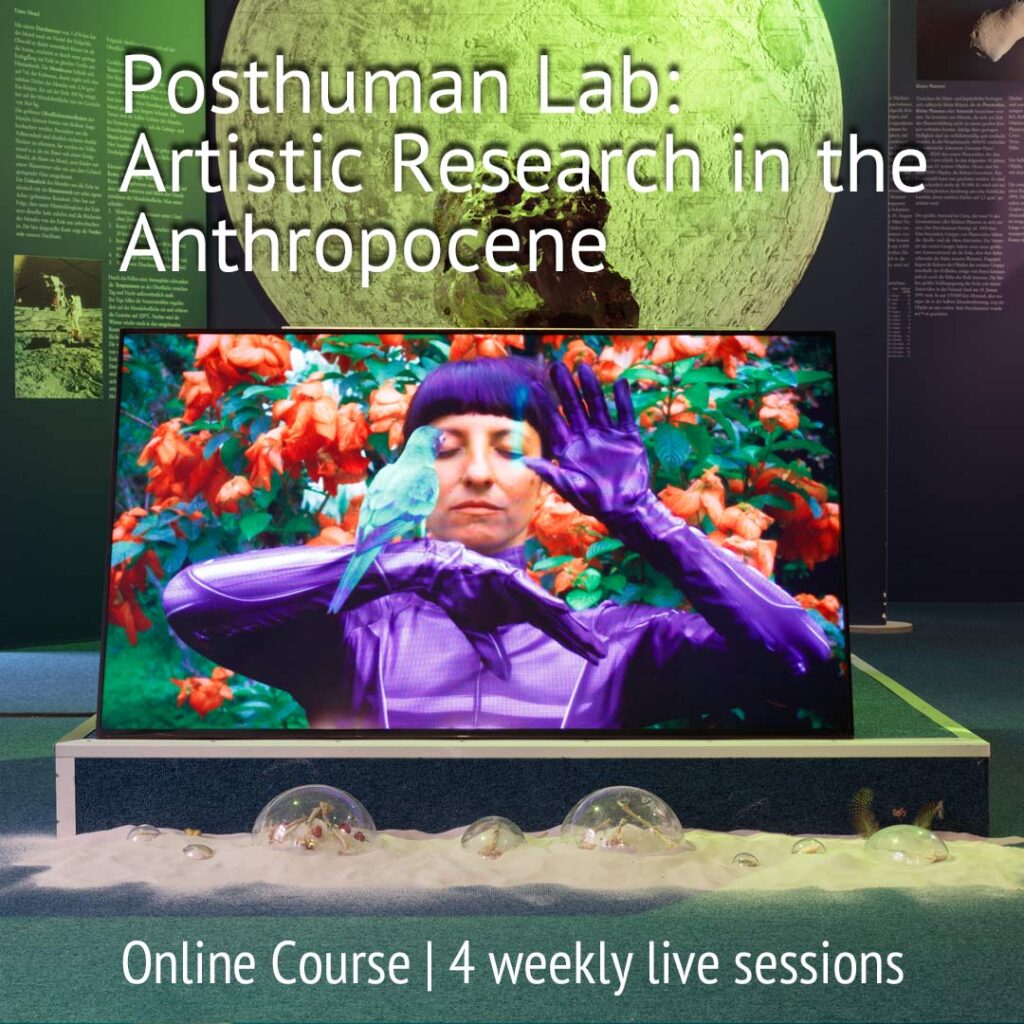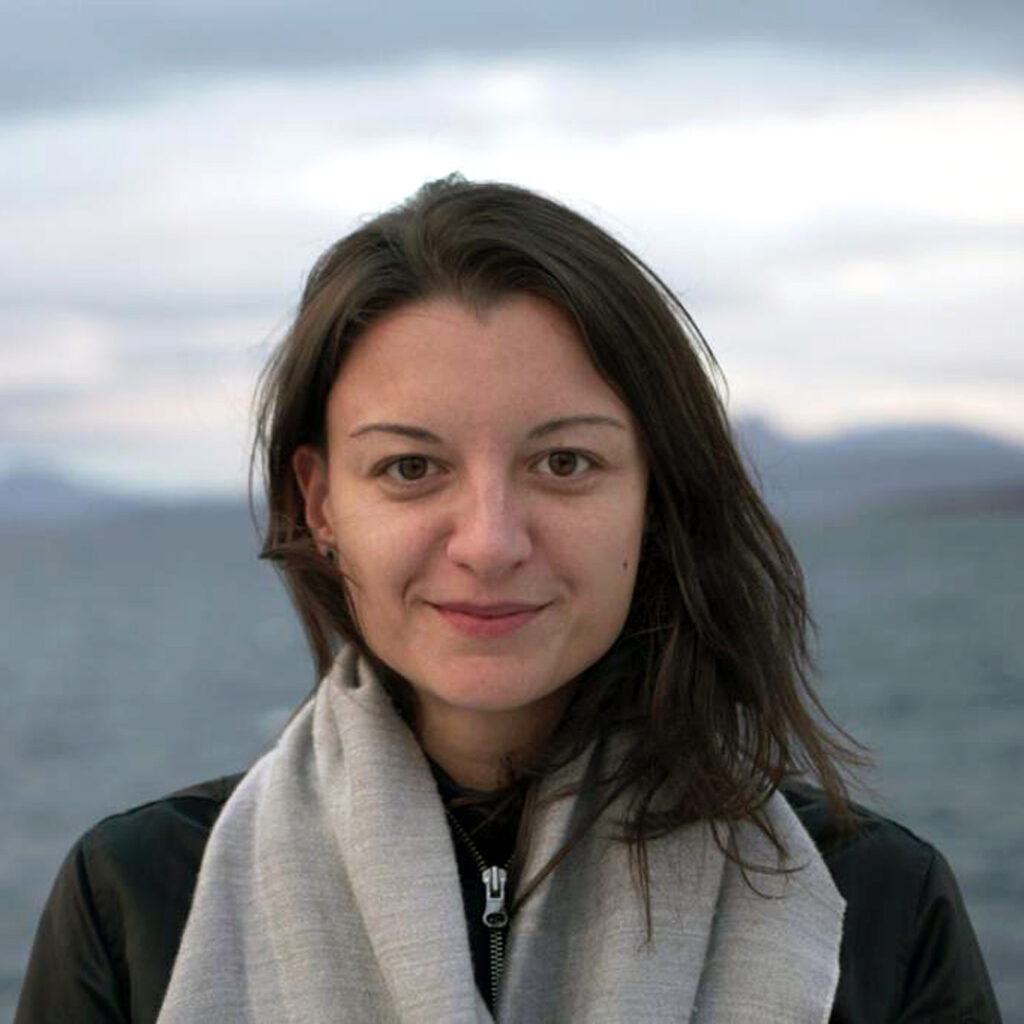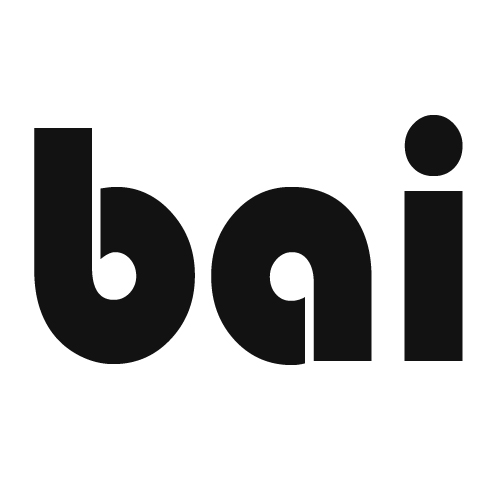Current Status
Price
Get Started

Photo by courtesy of Patricia Domínguez, Matrix Vegetal (2022). Installation view at SCB – Screen City Biennial Other Minds, at Archenhold Sternwarte (Berlin, 2022). Photo: Marjorie Brunet Plaza.
Enroll now as seats are limited:
Min. seats: 5 | Max. seats: 30 | Language: English
- Gain insights into the posthuman convergence and the historical construction of the notion of “human”, as well as its critiques.
- Get familiar with key concepts such as autopoiesis, human exceptionalism, more-than-human, “tentacular thinking” and holobiont.
- Feel encouraged to creative and critical thinking in addressing complex issues related to the Anthropocene.
- Achieve critical understanding of the differences between posthumanism and transhumanism, and the potential intersections.
- Rehearse the ability to critically analyze and interpret artworks and exhibitions that engage with posthumanism, the Anthropocene, and related discourses.
Online Course POSTHUMAN LAB: Artistic Research in the Anthropocene by Vanina Saracino
“In 1490, Italian artist and scientist Leonardo da Vinci created The Vitruvian Man, a drawing depicting a nude male body in two superimposed positions, inscribed within a circle and a square. This artwork encapsulates Leonardo’s notion of ideal body proportions while positing the human body as the fundamental unit of cosmic order and harmony, grounded in irrefutable Euclidean geometry. The Vitruvian Man—a white, male, abled, attractive, and possibly heterosexual human—became the archetypal representation of the human according to the artistic and scientific ideals of the High Renaissance, as well as one of the most iconic anthropocentric images in history. But what does “human” really mean?
As posited by Rosi Braidotti, the notion of the human has exploded under the double pressure of contemporary scientific advances and global economic concerns—not to mention the political ones, since “some of us are not even considered fully human now” (Braidotti, 2013). According to her, “after the postmodern, the post-colonial, the post-industrial, the post-communist and even the much contested post-feminist conditions, we seem to have entered the posthuman predicament”.
This historical period, in fact, is marked by a radical shift in the way we think about our species, and what we consider to be the common denominators of humanity. The human is now contended between two opposite poles: the posthumanist, which believes we have been overly influenced by Enlightenment ideas and calls for an off-centering of the human in favor of a more-than-human approach that acknowledges the irreplaceable interconnectedness of all species; and the transhumanist, which holds that we are still at an early stage in our co-evolution with technology and advocates for techno-transcendence and geoengineering as responses to climate breakdown.
The Posthuman Lab focuses on the posthumanist predicament by considering a wide range of visual artworks and theoretical texts that challenge the notion of the human, viewing us as one element in a complex ecosystem of entangled living matter. Donna Haraway, who resists the term posthuman and prefers to define herself as a compostist, reminds us that the root of the word human is the same as the word humus (soil): we are earthly beings born out of matter that is both terrestrial and stellar, and our existence is not independent but deeply entangled with that of every other critter on the planet. Complex, messy realities evolve through continuous, grounded, and generative processes. Artists, especially since the 2010s, have fully embraced this shift of paradigm working toward the dissolution of human-centered narratives through artistic research and practice. This course will embrace the posthumanist predicament through their views.” (Text by courtesy of Vanina Saracino)
Your BAI Online Course Instructor

Vanina Saracino (she/they) is an independent curator, film programmer, writer, and lecturer. Her work focuses on theories and art practices that question anthropocentric and binary worldviews from an intersectional perspective, with an emphasis on lens-based and time-based art. Between 2021–2025, Saracino has been serving as an adjunct professor of Experimental Film and Media Art at Universität der Künste (UdK), Berlin. With Adriana Alves, she curated the exhibition I converse with fire at NNKS – North Norwegian Art Center (Lofoten, Norway, 2025), first step in a larger project that reimagines energy through artistic research, titled Solar Kin. She co-curated two editions of the Screen City Biennial: Other Minds at Archenhold Observatory and other venues in Berlin (2022), and Ecologies – Lost, Found and Continued (Stavanger, Norway, 2019), where she also edited the SCB Journal, Vol.2.
With Alessandra Bargamaschi, she co-founded OLHO, a project about contemporary art and cinema initiated in Rio de Janeiro and São Paulo (2015–2018) and later shown at Palais de Tokyo and Palazzo Grassi (Teatrino). Saracino has additionally collaborated with Kumu Art Museum and EKKM (Tallinn), TBA21 – Academy, Salzburger Kunstverein (Salzburg), The EYE Film Institute (Amsterdam), and Centro Párraga (Murcia), among others. Saracino has realized residencies at ISCP – International Studio & Curatorial Program (New York City, June–July 2023), Q21 – MuseumsQuartier (Vienna, 2021), Fire Station Artists’ Studios (Dublin, 2019), CPR – Curatorial Program for Research (Reykjavik, Tórshavn, Tromsø, Boden, Luleå, Hyrynsalmi, Helsinki, 2018), GENERATOR – 40mcube/EESAB (Rennes, 2018), and was awarded research visiting grants by ProHelvetia (Switzerland, 2018), Goethe-Institut (NYC, 2018), The Danish Art Foundation (Copenhagen, 2018 and 2017) and Frame Contemporary Art Finland (Helsinki and Turku, 2019), among others. Graduated in Communication Science, Saracino holds an MA in Arts Management (GIOCA, University of Bologna) and in Philosophy and Art Theory (UAB, Autonomous University of Barcelona). Since 2015, she has been a member of IKT – International Association of Curators.
Save the dates in your calendar
The live sessions for this course will be given on Monday February 02, 09, 16 and 23, 2026, each day from 4 – 6 pm (Berlin time). You will also receive an email reminder for each video conference before it takes place.
Recording of Live Sessions
We record the live sessions so that they remain available for a logged in course participant until one week after the last session. Please check before booking a course the technical requirements as listed below.
Access to content
You will get access to the course content and lessons in our learning management system once you are enrolled.
Technical requirements
We will use the Zoom Meeting application for the live sessions. You need a stable internet connection. There are two ways to access the live meeting:
1. Via the Zoom app
Before joining a Zoom meeting on a computer or mobile device, you can download the Zoom app here: https://zoom.us/download
or on: https://apps.apple.com/de/app/zoom-cloud-meetings/id546505307
Otherwise, you will be prompted to download and install Zoom when you click our join the zoom meeting link.
2. Via Google Chrome Browser on https://zoom.us/join
If you are using Google Chrome to join a meeting, you will see a dialog box to launch the Zoom application.
https://support.zoom.us/hc/en-us/articles/201362593-Launching-Zoom-from-a-web-browser
Here you find more info: https://youtu.be/hIkCmbvAHQQ
We will provide the Zoom Meeting ID before each meeting. BAI will record the live sessions.
For Windows, macOS, and Linux:
https://support.zoom.us/hc/en-us/articles/201362023-System-requirements-for-Windows-macOS-and-Linux
In addition to the Online Program, the Berlin Art Institute offers an international Studio Program, a Residency Program, Portfolio Courses, a Spring Academy, a Summer School, an Arts Incubator, a Friends Program, and the presentation and exhibition display 404 | BAI.
If you have any questions, please contact us at ecourses@berlinartinstitute.com

